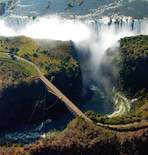History of Victoria Falls
The Sacred Falls
It would be fair to assume that this remarkable phenomenon has always had a mystical connotation.Livingstone wrote that he was invited to a ceremony on what is now Livingstone Island where three Batoka chiefs offered prayers and sacrifices to the gods (barimo):
"They chose their places of prayer within the sound of the roar of the cataract, and in sight of the bright bows in the cloud ... The play of colours of the double iris on the cloud, seen by them elsewhere only as the rainbow, may have led to the idea that this was the abode of Deity. Some of the Makolo who went with me ... looked upon the same sign with awe. When seen in the heavens it is named Motse-oa-Barimo, "the pestle of the gods".
There are a number of sacred shrines in the area, including those on Livingstone Island, where the more traditional members of the Lozi clan regularly pay homage to their ancestors. For them, the Falls represents a place to reflect on the transcendental nature of life, to honour those who have gone before, and to try and honour their memory with personal purity.
Among the pioneering written records of human interaction with the Falls was the 1878 description by the French missionary Francois Coillard of a Tonga ceremony on Livingstone Island. He described in his diary how the local inhabitants "believe it is haunted by a malevolent and cruel divinity, and they make offerings to conciliate its favour, a bead necklace, a bracelet or some other object, which they fling into the abyss, bursting into lugubrious incantations, quite in harmony with their dread and horror".
Many colonial writers were equally horrified. Decle peered over the edge of Devil's Cataract during the 1890s and described it as "hell itself, a corner of which seems to open at your feet: a dark and terrible hell, from the middle of which you expect every moment to see some repulsive monster rising in anger".
Personally, the authors identify with the view of the eccentric German explorer Edward Mohr who wrote of the Falls in 1876: "It seemed to me as if my own identity were swallowed up in the surrounding glory, the voice of which rolled on forever, like the waves of eternity ... no human being can describe the infinite; and what I saw was a part of infinity made visible and framed in beauty".
It is something of colonial impudence that the term Victoria Falls is the most recognised name for such a deeply African phenomenon. This was the name given by Livingstone in honour of Queen Victoria, the reigning monarch of England at the time.
The poetic Mosi-oa-Tunya, the "smoke that thunders", is far more appropriate - particularly since Zimbabwe and Zambia, whose borders meet at the Falls, are committed to an anti-colonial struggle. However, Livingstone's name has stuck, and in today's marketing-orientated world, the Victoria Falls has become the brand by which one of the world's seven natural wonders is known to the outside world.
Brett Hilton-Barber and Lee R. Berger. Copyright © 2010 Prime Origins.
Victoria Falls History - It is clear from archaeological sites around the Victoria Falls that the area has been occupied from around 3 milli...
more

 Victoria Falls History - It is clear from archaeological sites around the Victoria Falls that the area has been occupied from around 3 milli...
Victoria Falls History - It is clear from archaeological sites around the Victoria Falls that the area has been occupied from around 3 milli...